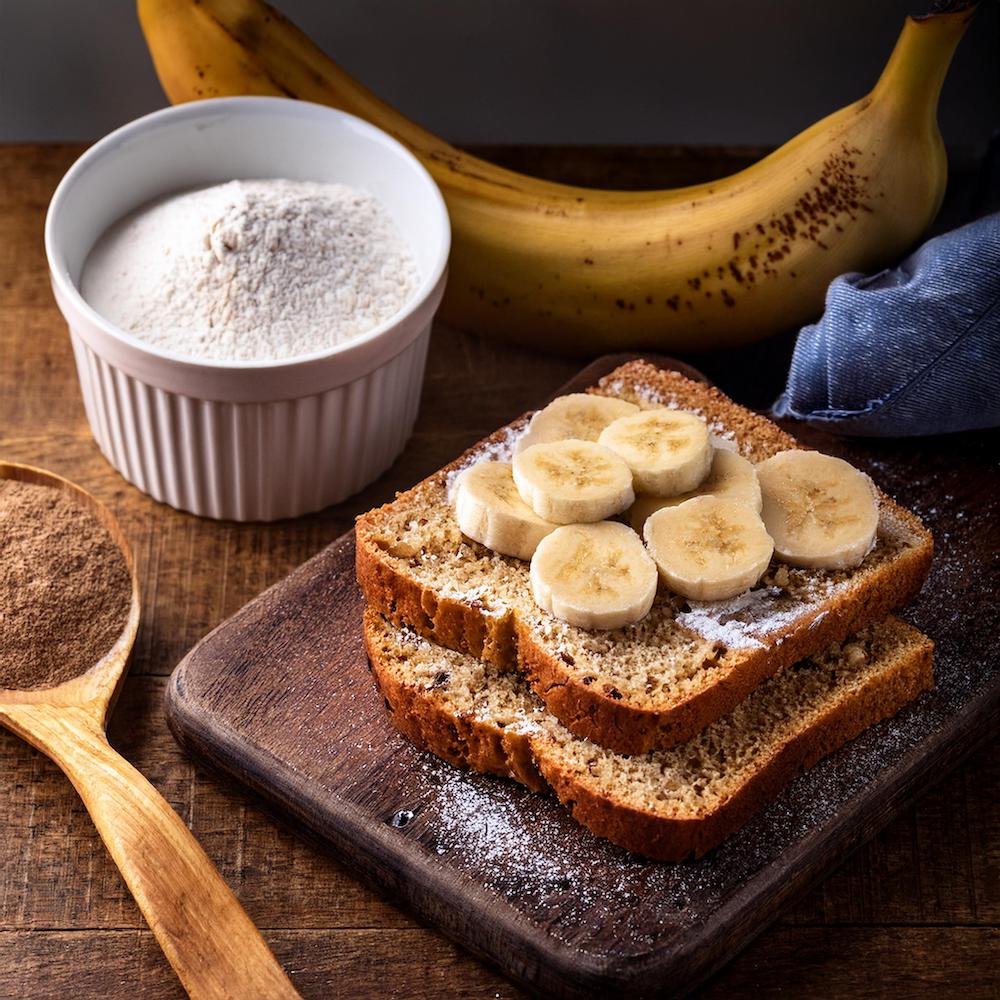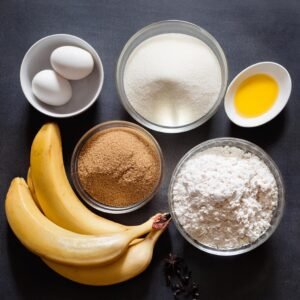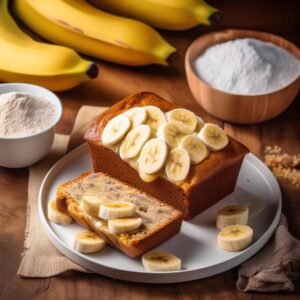What Can I Use If I Don’t Have Baking Soda for Banana Bread? Banana bread is a timeless classic—a perfect solution for using up overripe bananas and creating a moist, flavorful treat. But what can I use if I don’t have baking soda for banana bread? Don’t panic! Whether you’ve run out of baking soda or are simply looking for alternatives, this guide will walk you through the best substitutes and how to adjust your recipe.
So, if you’re wondering what can I use if I don’t have baking soda for banana bread, you’ve come to the right place. From baking powder to self-rising flour, we’ve got all the tips you need to ensure your banana bread turns out soft, fluffy, and delicious every time!
What Is Baking Soda and Why Is It Important in Banana Bread?
Baking soda is a leavening agent, scientifically known as sodium bicarbonate. Its primary function in baking is to create gas bubbles that help dough or batter rise. In banana bread, baking soda reacts with acidic ingredients like buttermilk, yogurt, or ripe bananas to release carbon dioxide. This reaction forms tiny air pockets, giving the bread its signature soft, fluffy texture.
Why Baking Soda Works in Banana Bread
Bananas are naturally acidic, making them a perfect partner for baking soda. When combined, their interaction produces the gas necessary for leavening. Without baking soda, the bread may not rise as well, resulting in a denser loaf. However, the good news is that there are substitutes that can replicate its effects.
What Happens If You Don’t Use Baking Soda in Banana Bread?
Baking soda is a key leavening agent in banana bread, playing an essential role in helping the batter rise. Its reaction with acidic ingredients, such as overripe bananas or buttermilk, produces carbon dioxide gas, which creates the bubbles responsible for the bread’s fluffy texture. Without it, several issues can arise, but what can I use if I don’t have baking soda for banana bread? Let’s explore the challenges you might face if you skip it and don’t use a substitute:
1. A Dense, Flat Loaf
Without baking soda, your banana bread won’t rise properly. The batter will lack the lift needed to create that fluffy, airy texture. Instead, the bread will be dense, heavy, and flat, as there’s no leavening agent to introduce air into the mixture.
2. A Different Flavor Profile
Baking soda helps neutralize the acidity in recipes. Without it, the acidic ingredients in your banana bread—like overripe bananas or buttermilk—will dominate the flavor. This can make the bread taste tangier or slightly sour compared to the well-balanced sweetness you expect from banana bread. If you’re asking yourself, what can I use if I don’t have baking soda for banana bread?, the good news is that there are substitutes like baking powder that can help maintain flavor balance.
3. A Lack of the Airy Texture
Baking soda plays a vital role in creating the light, soft crumb that makes banana bread so appealing. Without it, the bread’s texture will feel heavier and less enjoyable.
Top Substitutes for Baking Soda in Banana Bread
When replacing baking soda, it’s essential to choose substitutes that mimic its leavening effects. If you’ve ever wondered what can I use if I don’t have baking soda for banana bread? here are the best alternatives to save your recipe:
1. Baking Powder
The most reliable substitute is baking powder, a complete leavening agent that doesn’t require acidic ingredients to activate.
- How to Use: Replace each teaspoon of baking soda with 3 teaspoons of baking powder.
- Pros: Creates a light, fluffy texture similar to baking soda.
- Cons: Doesn’t neutralize acidity, which may slightly alter the flavor.
2. Self-Rising Flour
Self-rising flour, containing pre-mixed baking powder and salt, is an excellent alternative when baking soda or powder is unavailable.
- How to Use: Swap all-purpose flour with an equal amount of self-rising flour, omitting additional salt and baking powder.
- Best For: Recipes needing consistent results.
3. Whipped Egg Whites
Whipped egg whites add natural leavening by incorporating air into the batter, perfect for recipes with a lighter texture.
- How to Use: Whip 2 egg whites to stiff peaks and gently fold them into the batter as the final step.
- Pro Tip: Avoid overmixing to maintain airiness.
4. Club Soda
Club soda’s carbonation provides mild leavening, though it’s less potent than baking powder or soda.
- How to Use: Replace equal amounts of liquid (like milk or water) in the recipe with club soda.
- Best For: Recipes needing gentle leavening.
5. Yogurt or Buttermilk
These acidic ingredients pair well with baking powder to mimic the effects of baking soda.
- How to Use: Substitute part of the liquid in your recipe with yogurt or buttermilk and add 3 teaspoons of baking powder for every teaspoon of baking soda.
- Pro Tip: If your recipe already includes acidic ingredients, reduce them to maintain balance.
So, what can I use if I don’t have baking soda for banana bread? With options like baking powder, whipped egg whites, or yogurt, you can still bake a fluffy, flavorful loaf without missing a beat!
How to Adjust Recipes When Using Baking Soda Substitutes
When using substitutes, it’s important to tweak your recipe to maintain the desired balance of flavors and textures. If you’re asking, what can I use if I don’t have baking soda for banana bread? here are some key adjustments to ensure success:
1. Adjust Proportions
- Baking powder is less concentrated than baking soda, so you’ll need three times as much.
- Substitutes like yogurt or buttermilk may add extra liquid. Reduce other liquids in the recipe to compensate.
2. Monitor Baking Time
- Baking powder works more slowly than baking soda, so the batter may take slightly longer to rise and bake. Keep an eye on your bread while baking.
3. Test for Freshness
- Old substitutes like baking powder or self-rising flour may lose effectiveness. Check expiration dates to ensure they provide proper leavening.
4. Consider Flavor Changes
- Baking soda neutralizes acidic flavors. Without it, your banana bread may taste tangier. Add vanilla extract, cinnamon, or sugar to balance the flavor.
By making these adjustments, you’ll know exactly what can I use if I don’t have baking soda for banana bread and how to create a delicious loaf with perfect flavor and texture!
Step-by-Step Recipe: Banana Bread Without Baking Soda
Here’s a detailed guide to making banana bread without baking soda. This recipe uses baking powder as the substitute for simplicity.
 Ingredients for Banana Bread Without Baking Soda
Ingredients for Banana Bread Without Baking Soda
- 3 overripe bananas, mashed (about 1 1/4 cups)
- 1 1/2 cups all-purpose flour
- 1 1/2 teaspoons baking powder
- 1/3 cup melted butter
- 1/3 cup granulated sugar
- 1/3 cup brown sugar
- 1 large egg
- 1 teaspoon vanilla extract
- 1/4 teaspoon salt
- 1/2 teaspoon ground cinnamon (optional)
Step-by-Step Instructions
1. Preheat Your Oven
- Preheat your oven to 350°F (175°C).
- Prepare a 9×5-inch loaf pan by greasing it with butter or a non-stick spray. Alternatively, line the pan with parchment paper for easy removal. Ensure the parchment extends over the edges to act as handles for lifting the bread out later.
2. Mix Wet Ingredients
- In a large mixing bowl, mash the 3 overripe bananas until smooth and lump-free.
- Add the 1/3 cup melted butter, 1/3 cup granulated sugar, 1/3 cup brown sugar, 1 large egg, and 1 teaspoon vanilla extract. Stir the ingredients together until well blended.
- Ensure there are no lumps of sugar, and the mixture is smooth for an even batter.
3. Combine Dry Ingredients
- In a separate medium-sized bowl, whisk together the 1 1/2 cups all-purpose flour, 1 1/2 teaspoons baking powder, 1/4 teaspoon salt, and 1/2 teaspoon ground cinnamon (optional).
- Whisking ensures the dry ingredients are evenly distributed and helps create a fluffier bread.
4. Blend Wet and Dry Mixtures
- Gradually add the dry ingredients to the wet banana mixture. Fold them together gently using a spatula or wooden spoon.
- Mix only until the flour is just incorporated—overmixing can activate the gluten in the flour, resulting in dense bread.
5. Add Optional Extras (Optional)
- At this stage, you can enhance your banana bread with 1/2 cup of chocolate chips, chopped walnuts, pecans, or dried fruits like raisins or cranberries.
- Gently fold in your chosen add-ins to distribute them evenly throughout the batter.
6. Pour and Bake
- Pour the batter into the prepared loaf pan. Use a spatula to spread it evenly and smooth the top.
- Place the pan in the preheated oven on the center rack. Bake for 40-50 minutes.
- Check for doneness by inserting a toothpick or skewer into the center of the loaf. If it comes out clean or with just a few moist crumbs, the bread is ready.
7. Cool and Serve
- Remove the pan from the oven and allow the bread to cool inside the pan for 10 minutes.
- Carefully transfer the bread to a wire rack and let it cool completely before slicing. Cooling helps the bread set, making slicing easier and reducing crumbling.
- Serve plain, or pair it with butter, cream cheese, or your favorite spread.
Pro Tips for Perfect Banana Bread Without Baking Soda
Follow these tips to elevate your banana bread game and make sure each loaf turns out perfectly, even if you’re asking, what can I use if I don’t have baking soda for banana bread?
1. Use Overripe Bananas
Overripe bananas with brown or black spots are sweeter and softer, which enhances both the flavor and texture of your bread.
2. Avoid Overmixing
Gently fold the wet and dry ingredients together. Overmixing activates gluten, resulting in dense bread. Stop as soon as no streaks of flour are visible.
3. Don’t Skip Cooling
Let the bread cool in the pan for 10 minutes before transferring it to a wire rack. This prevents crumbling and allows for clean, even slices.
4. Measure Ingredients Accurately
Use proper measuring tools and level off ingredients like flour with a knife. Too much flour can lead to dense bread.
5. Test for Doneness
Insert a toothpick into the center. If it comes out clean or with a few moist crumbs, the bread is done. If wet batter sticks, bake for 5–10 more minutes and check again.
6. Experiment with Add-Ins
Mix in chocolate chips, nuts, or dried fruits for extra flavor. You can also sprinkle cinnamon sugar or add banana slices on top for a decorative touch.
7. Use Room Temperature Ingredients
Allow butter, eggs, and other wet ingredients to reach room temperature for smooth batter and even baking.
8. Store and Freeze
Keep banana bread fresh by storing it in an airtight container for up to 4 days at room temperature or 1 week in the fridge. Freeze individual slices wrapped in plastic for up to 3 months.
By following these tips, including using substitutes when needed, like baking powder, you’ll never have to wonder what can I use if I don’t have baking soda for banana bread? Your loaf will always turn out moist, flavorful, and perfectly baked!
Common Mistakes to Avoid
If you’re wondering, what can I use if I don’t have baking soda for banana bread? it’s just as important to know what mistakes to avoid. Here’s how to ensure your loaf turns out perfectly:
1. Using Expired Ingredients
Substitutes like baking powder or self-rising flour lose potency over time. Using expired leavening agents can result in a flat, dense loaf. Always check expiration dates and test baking powder by adding a small amount to warm water—if it bubbles, it’s still effective.
2. Skipping Adjustments
When replacing baking soda with baking powder, you need to adjust the recipe. Baking powder already contains acid and base, so eliminate additional acidic ingredients like buttermilk or vinegar to avoid an overly tangy flavor. Failing to make these adjustments can also disrupt the liquid balance, affecting the batter’s texture. Focus on ingredients that highlight the banana flavor without altering the recipe.
3. Overbaking
Baking without baking soda may require slightly longer baking times since baking powder reacts more slowly. However, overbaking can dry out your banana bread. Start checking for doneness around the 40-minute mark. Insert a toothpick into the center—if it comes out clean or with a few crumbs, it’s ready. If the top starts to brown too quickly, cover it with foil to prevent burning.
By avoiding these common mistakes, you’ll know exactly what can I use if I don’t have baking soda for banana bread and how to adjust for a moist, fluffy, and flavorful loaf!
Creative Variations for Banana Bread Without Baking Soda
1. Chocolate Banana Bread
- Add 1/4 cup cocoa powder to the dry ingredients and fold in chocolate chips for a rich twist.
2. Vegan Banana Bread
- Replace the egg with a flaxseed mixture (1 tbsp flaxseed meal + 3 tbsp water) and use coconut oil instead of butter.
3. Gluten-Free Banana Bread
- Use a gluten-free flour blend that includes xanthan gum for structure.
4. Low-Sugar Banana Bread
- Substitute half the sugar with honey or maple syrup. Adjust liquids accordingly.
Suggested Internal Links:
- Banana Bread Recipe Without Baking Soda
Directly connects to a practical application of the topic, providing readers with a recipe that aligns with the content’s focus. - What Can I Use If I Don’t Have Baking Soda?
Broadens the discussion to other baking scenarios, making it useful for readers interested in general alternatives. - Is It OK to Bake Without Baking Soda?
Explores the feasibility of baking without baking soda, which complements the banana bread-specific content. - What Is a Substitute for Baking Soda in Bread Recipes?
Expands on potential substitutes for baking soda, offering additional insights for readers exploring alternative ingredients. - Will Bread Rise Without Baking Soda?
Provides a deeper understanding of the impact of omitting baking soda in bread recipes, adding scientific and practical context.
FAQs About Baking Banana Bread Without Baking Soda
1. Can I Skip Baking Soda Entirely?
Yes, but your bread may turn out dense and heavy. Using a substitute like baking powder ensures better results.
2. Will My Banana Bread Taste Different Without Baking Soda?
Slightly. Baking soda neutralizes acidity, so without it, the bread may taste tangier. This can be balanced with sugar or vanilla.
3. Can I Use Yeast Instead of Baking Soda?
While yeast can technically be used as a leavening agent, it’s not ideal for banana bread. Yeast requires fermentation time, which alters the flavor and texture.
4. What’s the Easiest Substitute for Baking Soda?
Baking powder is the easiest and most effective substitute for baking soda in banana bread
Conclusion
Wondering what can I use if I don’t have baking soda for banana bread? Don’t worry—running out of baking soda doesn’t mean you can’t enjoy a delicious loaf. Substitutes like baking powder, self-rising flour, or whipped egg whites can help you achieve that same soft, moist texture and incredible flavor.
By using the tips and suggestions in this guide, you’ll know exactly what can I use if I don’t have baking soda for banana bread and how to make it work seamlessly. So grab those ripe bananas and get baking—because no baking soda means no problem!
Craving more tasty recipes? Make sure to follow us on Facebook , Instagram, Pinterest, and Twitter for daily updates and kitchen inspiration!

 Ingredients for Banana Bread Without Baking Soda
Ingredients for Banana Bread Without Baking Soda